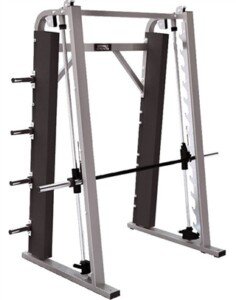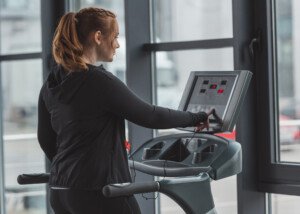
If you have a workout program that suggests “Smith machine bar in an incline” for women unable to do pull-ups, and you don’t know what this means, then here is the explanation.
Pull-ups Using a Smith Machine at “Incline”
When I hear “Smith machine” and “pull-ups” in the same sentence, an image comes to mind:
• Setting the Smith bar high enough so that you can hang on it, legs bent so that feet are off the floor, and do pull-ups—feet never touching.
• For women who can’t do pull-ups but are almost there, it can mean letting your feet contact the floor at all times to subtract some body weight, or having them make contact for some of the time throughout the repetition.
But when we toss “incline” into the picture, only one thing comes to mind: Setting the bar low enough so that your BODY is inclined, at an angle, as you pull up and lower.
In other words, a “Smith machine bar in an incline” is an odd descriptor for an inverted row or “modified pull-up.”
If the OP’s workout plan literally says “Smith machine bar in an incline,” then whomever wrote that must have been half-asleep at the time.
The OP thought that “incline” meant place an inclined bench under the Smith bar, sit in it, then pull up off the bench, then lower back into the bench.
I’d be extremely surprised if the workout plan really does call for this, as this would be a very inefficient way to do pull-ups and get strong enough for real pull-ups.
First off, it would be a hassle just to drag the bench over to the Smith machine every single time for pull-ups.
Now imagine sitting in an inclined bench, Smith bar over you, grabbing the bar and lifting yourself out of the bench. How cumbersome and inefficient can this possibly get?
“Incline” obviously refers to the inclined angle of one’s body during a reverse row or the so-called modified pull-up.
Smith Machine Pull-ups
• The bar can be set at any number of heights, depending on one’s strength and body height.
• The Smith machine makes for a very convenient reverse row apparatus and is often used for this purpose.
• Get under the bar, but make sure the height is high enough to allow full extension of your arms as you hang.
• Your body is straight out in front of you, but because the bar is higher than the floor, your body will be inclined.
• Your heels are on the floor, feet up.
• Keep your body straight and pull up. Your chest should come up under the bar.
• Keep your body as straight as a plank of wood throughout the set.
• If it’s too difficult to pull yourself all the way up, raise the bar.
• Raising the bar will make your body more upright but still “inclined.” But the move will be easier.
• This is the same move that you’ve probably seen many times being done using suspension straps.
To get strong enough for pull-ups, I recommend using the Smith machine bar while your body is 100 percent upright—but many women will need to build up to even this point.

























